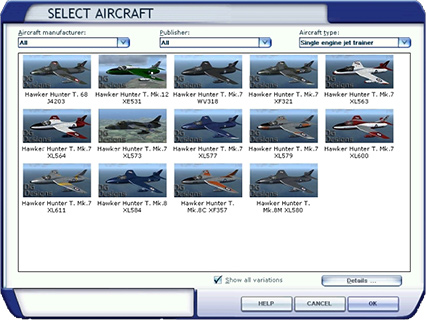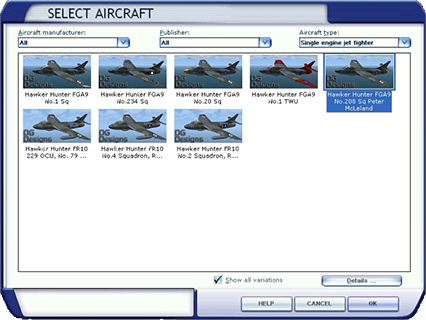Hawker Hunter T7/FGA9
For FSX by Dave Garwood
Reviewed by Kieran Marshall
July 2011
Background
Ah, the gorgeous Hunter. Born out of the Sea Hawk, it was the
faster, younger brother. It’s swept back wings made it fast and
also nimble. Personally, I’ve never seen a Hunter fly. I’ve seen
5 of the type, all ‘stuffed’ and in museums. But this stunning
freeware aircraft allows me to feel what flying a Hunter felt
like (minus any sharp corners or smells)
But first, a little bit of history. First flown on 20 July 1951,
it was a development of the Sea Hawk. This was a straight wing
aircraft and was powered by the Rolls-Royce Nene engine. It
attracted no RAF interest, although the Navy took it. The Hunter
was what the RAF wanted. It was fast and could reach 45000ft. On
7 September 1953, the sole Hunter Mk 3 (the modified first
prototype, WB 188) flown by Neville Duke broke the world air
speed record, achieving 727.63 mph (1,171.01 km/h) over
Littlehampton.
The Hunter entered service as the F1 in July 1945 with 43
Squadron. Over the years, more versions were produced, both for
the home market and for export. The Swiss Air Force was a major
operator of the Hunter, taking 160 of both the single seat Mk58A
and the T Mk68 (included in the T7 pack). The Swedish Air Force
also took a number of Hunters. But, since the 1990’s, the RAF
and the Royal Navy withdrew the Hunter from the fleets.
The Lebanese Air Force still uses some Hunters. But most of the
flying ones these days are in civilian hands. ‘Miss Demeanor’ is
a Mk58 that is probably the most famous Hunter, as it is in an
eye-catching splash of colour-scheme.
That’s the end of the short history lesson from me. For more
information on the Hawker Hunter, please visit
this site
Downloading and installing
Downloading was quick and easy from the BritSim website. This is
the FSX model by the way, the FS2004 one is still available from
Classic British Flight Sim. Anyway, the download sizes are:
Hunter F9 – 47.3mb
Hunter Trainers – 67.6mb
What you get:
Hunter T7 – T68 J4203 (Swiss Air Force)
T7 WV318 (Royal Air Force Dark Blue/Black)br />T7 XF321 (Royal Air Force Grey/Green Camouflage with checks)
T7 XL563 (White/Red/Blue of the Empires Test Pilots School)
T7 XL564 (White/Red/Blue of the Empires Test Pilots School)
T7 XL573 (Royal Air Force Grey/Green overall camouflage)
T7 XL577 (Royal Air Force Overall Mid-Blue)
T7 XL579 (Royal Air Force Overall Grey with Hi-Vis orange
stripes)
T7 XL600 (White/Red/Blue of the Empires Test Pilots School)
T7 XL611 (Royal Air Force Overall Grey with Hi-Vis yellow
stripes)
T8 XL584 (Royal Navy overall Blue)
T8C XF357 (Royal Air Force Overall Grey with orange Hi-Vis tail)
T8M XL580 (Royal Navy Sea Grey top over White)
T12 XE531 (Royal Air Force Overall Green/White)
Hunter FGA9 – FGA9 XE624 (Royal Air Force Grey/Green over
Mid-grey)
FGA9 XE624 (Royal Air Force Grey/Green over dark-grey)
FGA9 XF414 (Royal Air Force Grey/Green over Mid-grey with yellow radar)
FGA9 XF418 (Royal Air Force Grey/Green over Mid-grey with Red tail and wing ends)
FGA9 XE609 (Royal Air Force Grey/Green over Mid-grey, flown by Peter McLeland)
FR10 XG168 (Royal Air Force Grey/Green over Mid-grey)
FR10 XJ714 (Royal Air Force Grey/Green over Mid-grey)
FR10 WW596 (Royal Air Force Grey/Green over Mid-grey)
In the FGA9 pack, there are differences between the camouflages, namely squadron decals and the area around the roundels on the fuselage.
Pilot’s notes in traditional Air Ministry style
Visual of what you get:
 |
 |
Exterior
Having seen various Hunters in museums, I thought I understood what a Hunter looked like etc. But seeing this model (and having to find photos), I was wrong. Every nut and bolt seems to be modelled. The textures make an already gorgeous airframe look even better. Some weathering would have been appreciated, but the dull matt finish looks realistic for a Hunter.
But that’s not all. Once the engine has wound down (be prepared to wait for a minute or two), an orange crew ladder appears, along with chocks and engine covers and ‘Remove before Flight’ covers. These add to an already stunning model. I’m impressed that it’s freeware – I’d happily pay €20-€30 for this model on exterior looks alone. Take a look at these screenshots and have a look for yourself!
 |
 |
 |
 |
 |
 |
 |
 |
Unfortunately, the cannons don’t work. This is a shame since the gun-sight on the FGA9 model works. But, if you have the drop tanks, you can ‘punch’ them off the aircraft using the yellow/black button on the panel.
Interior
Climbing into the cockpit is a revelation. The 2-D is nothing to write about, being the original FS9 panel. All the gauges work, except for the Mach-meter, which doesn’t seem to work. But, whilst it’s a good representation of the Hunter cockpit, it offers nothing like the functionality of the VC.
The 2D
 |
2D pop-ups are available, which consist of: An autopilot (modern luxury), the default GPS, fuel panel, radios and the centre console
 All the 2-D pop-ups |
 FGA9 VC |
 T7 VC |
The VC views are – The Main Panel, the co-pilot’s panel (T7 only), the VHF ARC-52 Controller and the Radio. Some of the VC Views...
 |
 |
Sounds
The sounds are produced by Mark Cranston of Aero Musica. They sound like a good, solid representation of the Rolls-Royce Avon. These sounds are a little quiet to me, not by much, but could do with turning up a little bit. This may be just my system (see end of review) or my ears, having never seen or heard a Hunter in flight, but the sounds made by Christoffer Petersen for Dave’s FS9 Hunters are louder.
Flight Dynamics
Having never flown a Hunter, I can’t say for sure how good/bad the flight dynamics are. But they feel right. The engine is reasonably slow to pick up, only a gap of about 2-4 seconds. This is accurate as the Avon wasn’t the fastest engine to pick up.
After rotating at about 150kts, the elevator feels light and alive. It’s hard not to over-rotate and scrape the tail, due to that all-moving tail-plane. The ailerons are a bit on the heavy side up to about 300kts. Loops can be done, but you may not have enough speed to safely do it. The rudder is reasonable to my hands, being able to rock the aircraft around a bit.
Above 300kts, the ailerons come alive. Rolls can be done quickly and easily, with little effort. Barrel rolls are possible, but I’m not very good with them, so can’t be completely sure. The elevators are the same, being light, so it is possible to put the aircraft into a high speed stall. The rudder remains the same above 300kts.
Drop tanks don’t seem to affect the aircraft, but this could be because the Hunter doesn’t mind drop-tanks. Either way, I would have thought that the weight of the tanks with fuel would affect the performance somehow.
Flight
As a ‘sprog’ pilot, I decided to take the Hunter T7 J4203 up for a spin. As it was a Swiss Air Force example, I just had to fly out of a mountain airport, at about 7000ft!
Starting the engine up is a fun experience. All that power needs taming, but the aircraft can be heavy, so some power is needed to taxi. This reveals the first problem, but it is accurate. The Avon was a slow-ish engine to pick up and this is accurately portrayed.
 Taxi out |
You push the throttle forward and, after a gap of about 2 seconds, the engine gains power and pushes the Hunter forward. Rapidly, for a ‘heavy’ aircraft, she shoots off at about 150kts.
You’ve got to get the gear up quickly or the gear will exceed the maximum speed. Same for the flaps. As it happened, a rather large mountain loomed ahead, so a rapid pull-up was necessary. But the Hunter responded excellently, powering its way forwards and upwards. The all-moving tail plane gave an excellent response and we quickly climbed over the obstacle.
 Climbing |
 |
 |
 |
|
Finally, I needed to come down slowly, as I would be going into an airport with mountains all around. (Because of this, no screenshots were taken of the landing etc.)
The big airbrake at the rear of the aircraft slows us down quite nicely. The flaps are slowly notched down until the gear warning horn comes on. The gear swings down and with that, the airbrake comes in. This is because the airbrake will scrape along the tarmac due to its low position. A useful feature that, making sure you don’t break it Thanks to the tail-plane, the aircraft is easily placed onto the runway.
You can land it ‘on the numbers’ with a little practice. But you can float down the runway, so be careful. The brakes come on at slowly pull you down to about 180kts, then really kick in, bringing the aircraft to a stop.
Overall Experience
This is an excellent pair of packs. The sheer enjoyment of flying in the valleys, low and fast, in a British jet is amazing. The little extra pieces, like the crew ladders, chocks etc. add detail that is still missing in a few payware items. The joy of simply jumping into the aircraft, listening to that Avon whine up, then ‘beating up’ the skies reveals a simple theory – jump in and fly, forget the hours of ground school.
Frames rates – For both aircraft:
On the ground (RAF Coningsby default) – VC 24fps
Outside 15fps
In Flight at 4000ft - VC 15-35fps
Outside 10-20 fps
Note on Frame rates – Whilst 10-20fps may sound slow, and it is, but the default Cessna 172 barely tops 20fps outside, and about 20-30fps in the VC. This is because my system isn’t great for FSX, but will still run it
Total flight time – 3.4 hours since starting the review, 15hrs in total
![]()
Verdict
Pros:
-
Stunning looks
-
Variety while keeping up the standards
-
VC stunning with functions
-
Little/No drop in frame rates
-
Arrestor hook on two of the T7’s
-
It’s free!
Cons:
-
Nit-picking really, but the undercarriage bays are a little flat When catapulting, the nose dips into the deck, but doesn’t cause a crash
-
No other fixed camera view except for the Tail cam
Therefore, after hours of flying, I give Dave Garwood’s Hunter
FGA9 and T7 packs a 9.5/10. Only 9.5 because of the little problems outlined above.
If these were fixed, it would easily score 10/10. But the Hunter does hold it’s own
against payware packs.
Mutley's Hangar score of 9.5/10
![]()



